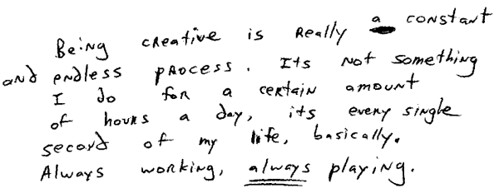Words from James Kochalka, courtesy of Dan Stafford’s hand-written interviews with cartoonists:

Here’s a cool post from Tom Kealey about writing and the importance of play.
Words from James Kochalka, courtesy of Dan Stafford’s hand-written interviews with cartoonists:

Here’s a cool post from Tom Kealey about writing and the importance of play.
Something to consider:
“What is art not? Well, as I’ve described it, Art is not about communication. Art is not a way of conveying information. It’s a way of understanding information. That is, creating a work of art is a means we have of making sense of the world, focusing to make it clearer, not a way of communicating some understanding of the world that we already hold. If you already hold a clear understanding of whatever then there’s no reason to create the work of art. So you don’t. In fact, you can’t. If you are trying to demonstrate some fact pictorially this is called illustration. Illustration is superficial, no matter how skilled, because it is secondary. The idea comes first and the illustration explicates it.”
– James Kochalka, “The Horrible Truth About Comics,” in THE CUTE MANIFESTO
“To construct a picture-story does not mean you must set yourself up as a master craftsman, to draw out every potential from your material —often down to the dregs! It does not mean you just devise caricatures with a pencil naturally frivolous. Nor is it simply to dramatize a proverb or illustrate a pun. You must actually invent some kind of play, where the parts are arranged by plan and form a satisfactory whole. You do not merely pen a joke or put a refrain in couplets. You make a book: good or bad, sober or silly, crazy or sound in sense.”
—Rudolph Töpffer, Essay on Physiognomy, 1845
* * *
Anything new: you wonder what to call it. I’m calling mine a graphic novel for the marketers. But what it really is is a Cartoon Novel. Or a novel-in-cartoons. Or just a book.
Kurt Vonnegut said he wrote Cat’s Cradle as if each chapter were a joke. Nathaniel West said he originally pictured Miss Lonelyhearts as a novel in comic strips.
I’m trying to write mine as if each page is a gag strip. Only the gags build into a story. And lots of them aren’t funny at all.
Peter Orner’s excellent new book is kind of like that. Each part is a little episode. And the episodes build into something big.
Whatever it is, it’s a book. This, I think, is a revelation.
* * *
– James Kochalka, quoted in Dylan Horrocks’ “The Perfect Planet: Comics, Games, and World-Building.”
* * *
George Saunders says that as a young boy, he felt the language in Esther Forbes’ Johnny Tremain was a code he could break, “a code that turned out to be more accurate and expressive than the one we all use to slog through normal life.” And breaking this code suggested to him that he might be able to come up with his own code, “a premonition that my complicated feelings about life could be subjugated to that quest, which has turned out to be true.”
People talk about voice and style, and I have no clue what they’re talking about. “Find your voice!” they say.
Screw that. I’m working on my secret code.
This site participates in the Amazon Affiliates program, the proceeds of which keep it free for anyone to read.